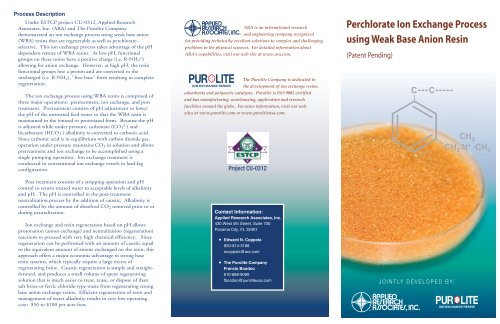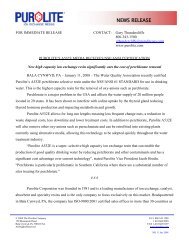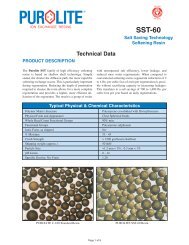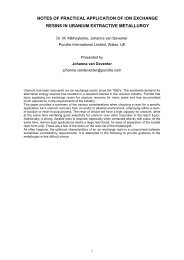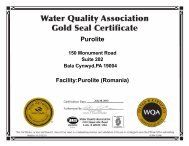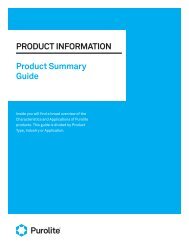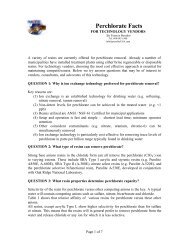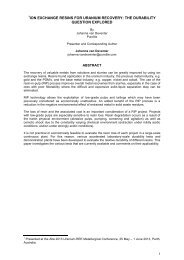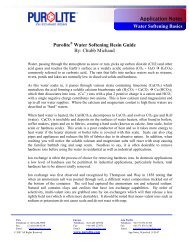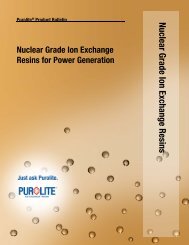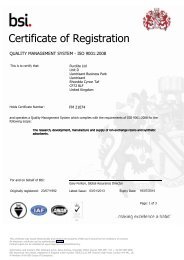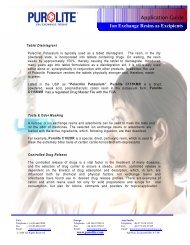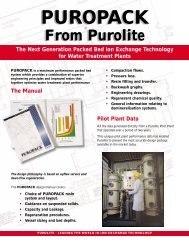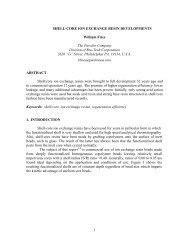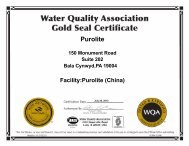Perchlorate Ion Exchange Process using Weak Base ... - Purolite
Perchlorate Ion Exchange Process using Weak Base ... - Purolite
Perchlorate Ion Exchange Process using Weak Base ... - Purolite
You also want an ePaper? Increase the reach of your titles
YUMPU automatically turns print PDFs into web optimized ePapers that Google loves.
<strong>Process</strong> Description<br />
Under ESTCP project CU-0312, Applied Research<br />
Associates, Inc. (ARA) and The <strong>Purolite</strong> Company<br />
demonstrated an ion exchange process <strong>using</strong> weak base anion<br />
(WBA) resins that are regenerable as well as perchlorateselective.<br />
This ion exchange process takes advantage of the pH<br />
dependent nature of WBA resins. At low pH, functional<br />
groups on these resins have a positive charge (i.e. R-NH + 3 )<br />
allowing for anion exchange. However, at high pH, the resin<br />
functional groups lose a proton and are converted to the<br />
uncharged (i.e. R-NH 2 ), "free-base" form resulting in complete<br />
regeneration.<br />
The ion exchange process <strong>using</strong> WBA resins is comprised of<br />
three major operations: pretreatment, ion exchange, and post<br />
treatment. Pretreatment consists of pH adjustment to lower<br />
the pH of the untreated feed water so that the WBA resin is<br />
maintained in the ionized or protonated form. Because the pH<br />
is adjusted while under pressure, carbonate (CO 3 2- ) and<br />
bicarbonate (HCO 3 - ) alkalinity is converted to carbonic acid.<br />
Since carbonic acid is in equilibrium with carbon dioxide gas,<br />
operation under pressure maintains CO 2 in solution and allows<br />
pretreatment and ion exchange to be accomplished <strong>using</strong> a<br />
single pumping operation. <strong>Ion</strong> exchange treatment is<br />
conducted in conventional ion exchange vessels in lead-lag<br />
configuration.<br />
®<br />
ARA is an international research<br />
and engineering company recognized<br />
for providing technically excellent solutions to complex and challenging<br />
problems in the physical sciences. For detailed information about<br />
ARA's capabilities, visit our web site at www.ara.com.<br />
The <strong>Purolite</strong> Company is dedicated to<br />
ION EXCHANGE RESINS<br />
the development of ion exchange resins,<br />
adsorbents and polymeric catalysts. <strong>Purolite</strong> is ISO 9002 certified<br />
and has manufacturing, wareho<strong>using</strong>, application and research<br />
facilities around the globe. For more information, visit our web<br />
sites at www.purolite.com or www.puroliteusa.com.<br />
Project CU-0312<br />
<strong>Perchlorate</strong> <strong>Ion</strong> <strong>Exchange</strong> <strong>Process</strong><br />
<strong>using</strong> <strong>Weak</strong> <strong>Base</strong> Anion Resin<br />
(Patent Pending)<br />
Post treatment consists of a stripping operation and pH<br />
control to return treated water to acceptable levels of alkalinity<br />
and pH. The pH is controlled in the post-treatment<br />
neutralization process by the addition of caustic. Alkalinity is<br />
controlled by the amount of dissolved CO 2 removed prior to or<br />
during neutralization.<br />
<strong>Ion</strong> exchange and resin regeneration based on pH allows<br />
protonation (anion exchange) and neutralization (regeneration)<br />
reactions to proceed with very high chemical efficiency. Since<br />
regeneration can be performed with an amount of caustic equal<br />
to the equivalent amount of anions exchanged on the resin, this<br />
approach offers a major economic advantage to strong base<br />
resin systems, which typically require a large excess of<br />
regenerating brine. Caustic regeneration is simple and straightforward,<br />
and produces a small volume of spent regenerating<br />
solution that is much easier to treat, reuse, or dispose of than<br />
salt brine or ferric chloride-type waste from regenerating strong<br />
base anion exchange resins. Efficient regeneration of resin and<br />
management of water alkalinity results in very low operating<br />
cost: $50 to $100 per acre-foot.<br />
Contact Information:<br />
Applied Research Associates, Inc.<br />
430 West 5th Street, Suite 700<br />
Panama City, FL 32401<br />
Edward N. Coppola<br />
850-914-3188<br />
ecoppola@ara.com<br />
The <strong>Purolite</strong> Company<br />
Francis Boodoo<br />
610-668-9090<br />
fboodoo@puroliteusa.com<br />
®<br />
JOINTLY DEVELOPED BY:<br />
ION EXCHANGE RESINS
Objective<br />
Demonstrate a novel, regenerable, perchlorate-selective ion exchange process that:<br />
Greatly minimizes waste volume<br />
Permits efficient waste reuse or disposal<br />
Reduces treatment costs compared to state-of-the-art<br />
regenerable & non-regenerable processes<br />
Approach<br />
Screened ion exchange resins and technologies<br />
Selected weak base anion (WBA) technology<br />
Developed an efficient, economical WBA treatment process<br />
Demonstrated WBA treatment process at Redstone Arsenal<br />
WBA <strong>Ion</strong> <strong>Exchange</strong><br />
<strong>Ion</strong> exchange and regeneration processes are accomplished by controlling pH<br />
At high pH, WBA resin functional groups are in the non-ionized, free-base form<br />
At low pH, functional groups are ionized enabling anion exchange<br />
WBA resin in free-base form (R-NH 2 ) is ionized (R-NH 3 + ) by protonating with acid (H + ):<br />
R-NH 2 + H + ➞ R-NH 3<br />
+<br />
Protonated resin removes anions (A - ) from aqueous streams:<br />
R-NH 3<br />
+<br />
+ A - ➞ R-NH 3 -A<br />
Spent resin (R-NH 3 -A) is regenerated by neutralizing with caustic (NaOH),<br />
which liberates anions and returns resin to the free-base form:<br />
R-NH 3 -A + Na + OH - ➞ R-NH 2 + HOH + Na + A -<br />
WBA <strong>Ion</strong> <strong>Exchange</strong> <strong>Process</strong> (Patent Pending)<br />
Pretreatment<br />
Reduce pH<br />
Acid<br />
Treated<br />
Water<br />
Contaminated<br />
Water<br />
<strong>Ion</strong> <strong>Exchange</strong><br />
Conventional<br />
Lead-Lag Equipment<br />
Lead <strong>Ion</strong><br />
<strong>Exchange</strong><br />
Vessel<br />
Post Treatment<br />
Restore pH<br />
and Alkalinity<br />
Lag <strong>Ion</strong><br />
<strong>Exchange</strong><br />
Vessel<br />
Bypass<br />
Caustic<br />
Degassing<br />
CO2 Removal<br />
Key Features:<br />
Conventional lead-lag<br />
configuration<br />
System pressure<br />
keeps dissolved<br />
CO 2 in solution<br />
Single pumping operation<br />
Stripping excess CO 2<br />
before neutralization<br />
minimizes post<br />
treatment cost<br />
Demonstration Site: Redstone Arsenal, AL<br />
Selected Well RS498<br />
6-inch Extraction well<br />
<strong>Perchlorate</strong>: 1500 to 2000 ppb<br />
Bicarbonate: 150 ppm<br />
Nitrate: 4 ppm<br />
Sulfate: 3 ppm<br />
Chloride: 4 ppm<br />
TCE: 3100 ppb<br />
Isotherm Results<br />
ClO 4 <strong>Exchange</strong>d on Resin (meq/L)<br />
110<br />
100<br />
90<br />
80<br />
70<br />
60<br />
<strong>Perchlorate</strong> concentration:<br />
600 to 1500 ppb<br />
WBA resin demonstrated:<br />
<strong>Perchlorate</strong> selectivity<br />
High exchange capacity<br />
y = 45.7x + 30.4<br />
50<br />
0.50 0.70 0.90 1.10 1.30 1.50<br />
ClO4 in Solution (mg/L)<br />
Pilot System Design & Operation<br />
Conventional lead-lag configuration<br />
Integrated pre- and post-treatment<br />
24 hr/day – 7 day/week operation<br />
2-inch diameter ion exchange columns<br />
Macroporus polystyrene divinylbenzene WBA resin<br />
36-inch bed depth<br />
12 to 24 bed volumes/hr treatment rate<br />
1.5 to 3 gpm/ft 3 of resin<br />
6 to 12 gallons/hour<br />
Demonstration<br />
began 6/23/05<br />
Demonstration<br />
completed 10/7/05<br />
15 week test<br />
5 test scenarios<br />
Pilot Breakthrough Curves<br />
Consistent with isotherm prediction<br />
<strong>Perchlorate</strong> removal to < MDL<br />
Effective over range of<br />
treatment rates<br />
Performance unaffected by<br />
regeneration<br />
<strong>Perchlorate</strong> (ug/L)<br />
500<br />
400<br />
300<br />
200<br />
100<br />
24 BV/Hour<br />
18 BV/Hour<br />
12 BV/Hour<br />
Lag Columns<br />
0<br />
0 1000 2000 3000 4000 5000 6000 7000 8000<br />
Water Treated (Bed Volumes)<br />
WBA Regeneration<br />
Successfully demonstrated three approaches<br />
Single-pass regeneration & protonation<br />
Batch regeneration & protonation<br />
Batch, “zero-discharge” regeneration<br />
& protonation<br />
Near 100% perchlorate removal<br />
Resin performance not affected by regeneration<br />
No perchlorate "leakage"<br />
No loss of treatment capacity<br />
Zero-Discharge Regeneration<br />
Scavenge spent regenerating and rinse<br />
solutions with strong base anion resin<br />
Reuse or discharge treated<br />
regenerating and rinse solutions<br />
O&M Cost: $5/acre-foot<br />
for drinking water (50 ppb)<br />
Biodegradation of<br />
Regenerating Solution<br />
Use existing CSTR technology<br />
Neutralize & dilute by ~50%<br />
Discharge treated regenerating<br />
solution to sewer<br />
O&M Cost: $2/kg of perchlorate<br />
Conclusion & Comparative Cost<br />
WBA IX process is:<br />
<strong>Perchlorate</strong>-selective<br />
High capacity<br />
Regenerable<br />
50 times more efficient<br />
than Cl - regeneration<br />
Zero discharge for<br />
drinking water<br />
Treatment Cost<br />
per Acre-Foot<br />
$400<br />
$300<br />
$200<br />
$100<br />
Low O&M cost: $50 to $100 per acre-foot<br />
Single-Pass Regeneration<br />
Clean<br />
Water<br />
Regen<br />
Tank<br />
Clean<br />
Water<br />
Caustic<br />
<strong>Perchlorate</strong><br />
Biodegradation<br />
System<br />
Herington, Kansas<br />
Caustic<br />
Clean<br />
Water<br />
Caustic<br />
Regen Rinse<br />
Tank<br />
Regen<br />
Tank<br />
Batch Regeneration<br />
Regen<br />
Tank<br />
Regenerant Scavenging<br />
Feed<br />
Pump<br />
Conventional<br />
NaCl Brine<br />
Regenerable<br />
<strong>Ion</strong><br />
<strong>Exchange</strong><br />
Vessel<br />
Clean<br />
Regen<br />
Water<br />
Rinse Scavenging<br />
Feed<br />
Pump<br />
Feed<br />
Pump<br />
Feed<br />
Pump<br />
<strong>Ion</strong><br />
<strong>Exchange</strong><br />
Vessel<br />
Clean<br />
Rinse<br />
Water<br />
<strong>Perchlorate</strong> Removal from Drinking Water<br />
Single-Use<br />
Disposable<br />
<strong>Ion</strong><br />
<strong>Exchange</strong><br />
Vessel<br />
<strong>Ion</strong><br />
<strong>Exchange</strong><br />
Vessel<br />
WBA Resin<br />
Regenerable<br />
Scavenger<br />
Resin<br />
Vessels<br />
Scavenger<br />
Resin<br />
Vessels


